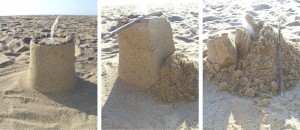Once we took our house off the market, I could focus on Mom, who had cancer. It was a great blessing to be able to spend extra time with her, walking through every stage of uncertainty, testing, trauma and pain as her life narrowed. In one of our many bedside chats, Mom said, “You know, Honey, you and Nate could probably sell your house without a realtor. We’ve done that four times. Why don’t you try it?”
Mom died in April, 2005. In May we needed to get the house back on the market and so followed her advice. We knew shoving a sign into the ground that said “For Sale By Owner” wouldn’t do much, since we were on a cul-de-sac, absent of drive-by value.
So we bought “Fizz-bo” (FSBO) signs and posted them at every nearby corner with arrows directing traffic flow to our address. We also made five-page packets describing our house and all its stats, complete with a dozen pictures. Once people turned onto our short street, they could see the clear plastic box of info next to the sign, beckoning them to take one.
Something else we did was lower the price of our home by 5%. After all, there would be no real estate commission when we sold it ourselves. Maybe a lower price would attract a new category of house hunters.
Over the next few weeks, as I worked in the kitchen keeping one eye out the window, an encouraging parade of drive-by vehicles moved past our house, stopping at the box of descriptive packets. As each person took one, I waved, smiled and thought, “Mom was right. This time it’s going to work.”
Quite a few families called and then toured our de-cluttered, squeaky-clean home. To go the extra mile, we held an open house every Sunday afternoon, locking the dog in the car and chatting with lookers by the hour. But an unproductive trend emerged. Most of those potential buyers had no potential. They fell into two categories: 1) “tire-kickers” wanting a peek, and 2) families visiting open houses as free entertainment.
About this time, Nate began clipping articles from newspapers that detailed a slight negative downturn in the real estate bubble. Several columnists predicted real estate doom as pie-in-the-sky prices were forced back “to reality.” Little did we know how far we still were from reality.
As the downward trend continued, we made the difficult decision to lower our price another 4%, spending hours discussing the issue. As a matter of fact, the sale of our house was all we ever talked about.
Falling into the “if only” trap produced days of hopelessness in both of us. Our kids begged to talk about something else, anything else, at the dinner table. And finally we declared a moratorium on talk of house and financial problems, at least while we ate. It was difficult to comply with the new rule, probably because it’s hard to fight fear.
When we lowered the price on the house for the second time, we printed new info sheets, noticing that we’d topped the one-thousand mark in our copies. One thousand people had removed packets from the plastic box on our front lawn, and still we hadn’t had a bite.
Even subtracting the months we’d been off the market when Mom was ill, the house had been for sale well over a year. Most of that time our suburb was, as the realtor put it, “Hot, hot, hot!” But by this time, our hope had grown cold, cold, cold.

 the game. Mom always laughed the hardest.
the game. Mom always laughed the hardest.